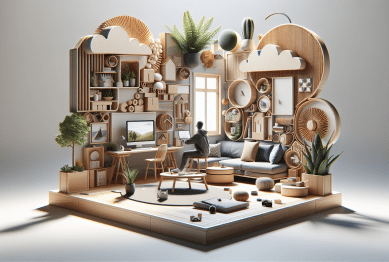Discover how adding indoor plants can revive your living space, improve air quality, and boost your mood. This guide explores plant care tips, popular varieties, and surprising lifestyle benefits that help you create a vibrant home sanctuary.
The Surprising Health Benefits of Indoor Plants
People often underestimate the health benefits of bringing indoor plants into their living spaces. Beyond enhancing décor, many popular plants purify air by removing harmful toxins and increasing oxygen levels. Studies led by environmental health researchers have highlighted that greenery can help reduce stress and even improve concentration. This sense of wellness is especially important as homes have become multifunctional spaces for work, rest, and entertainment. You might notice improved mood or easier breathing after just a few weeks of living with more indoor foliage. Don’t overlook the science-backed perks related to air quality and emotional well-being that these natural additions provide—transforming any room into a peaceful green oasis.
Cleaner air leads to a fresher environment, and certain species like peace lilies, spider plants, and snake plants are known for their effective air-filtering properties (Source: https://www.epa.gov/indoor-air-quality-iaq/inside-story-guide-indoor-air-quality). These varieties can absorb formaldehyde, benzene, and trichloroethylene, common in household products. Supporting better indoor climate, they don’t just look good; they actively help in maintaining a healthier atmosphere. For people with allergies or sensitivities, plants are a natural option for creating soothing spaces. The routine of caring for household greenery can even foster mindfulness, which is linked to lower anxiety and higher self-esteem, according to wellness practitioners.
Research also points out that engaging with plants stimulates relaxation responses in the brain—making people calmer and more energized (Source: https://www.ncbi.nlm.nih.gov/pmc/articles/PMC4419447/). When natural elements grace tablets, windowsills, or desks, the positive impact is both immediate and long-lasting. In fact, office productivity increases where greenery is present. Bringing plants inside the home is more than a design choice; it’s a move that nurtures overall wellness and keeps your living environment vibrant throughout the seasons.
Choosing the Right Indoor Plant for Every Room
Not every plant thrives in every corner of a home. Light, humidity, and temperature vary by room, which directly influences species selection. For instance, succulents and cacti do well in sunny windowsills, while ferns and calatheas prefer shaded and humid places such as bathrooms. One of the keys to lasting houseplant success is observing the specific needs of each type—and matching them to the setting. Choosing resilient, low-maintenance varieties like pothos or philodendrons can ensure beginners experience fewer obstacles.
Spaces like bedrooms benefit from calming and oxygen-producing options such as lavender or aloe vera. These contribute to a restful atmosphere and may even support better sleep cycles, as suggested by research into how plants influence indoor air and mood (Source: https://sleepfoundation.org/sleep-hygiene/bedroom-plants). Kitchens, on the other hand, offer ideal spots for culinary herbs like basil, rosemary, and mint. These functional plants delight the senses, provide readily available garnishes, and surprise guests with bursts of fragrance. Each room’s lighting should be factored into the plant selection process, as well as the lifestyle demands of the household.
If you’re often away, consider always opting for drought-resistant plants such as ZZ plant or snake plant, which tolerate skipped waterings. Meanwhile, living rooms welcome floor-to-ceiling options like monstera or fiddle-leaf fig, adding visual drama and fresh air. Grouping smaller pots together encourages humidity retention and can showcase a diverse collection. With smart placement and thoughtful choices, anyone can enjoy lush growth and the energy-boosting qualities of indoor greenery throughout the home.
Caring for Indoor Plants: Essential Tips for Every Home
Successful plant parenting isn’t about luck—it’s about understanding some basic principles and routines. Watering schedules vary by plant type; for example, succulents prefer drier soil while tropical plants need consistent moisture. Cut back on overwatering, as root rot is a common cause of decline among houseplants. Assess how fast the soil dries out and adjust watering accordingly. Good drainage is pivotal: always ensure pots have holes, and avoid letting plants sit in pooled water. This simple step goes a long way toward thriving foliage.
Light is another crucial factor. Rotate your pots every few weeks so all sides receive sun, preventing lopsided growth. If light is limited, explore options like grow lights or resilient low-light varieties. Dust leaves regularly; clean foliage absorbs more light, boosting overall plant health and helping them photosynthesize effectively. Adding humidity-loving plants to kitchens or bathrooms supports their needs naturally, while occasional misting helps tropical types thrive in drier spaces. Observe, experiment, and don’t fear moving a plant to improve its condition.
Finally, be patient—growth takes time. Fertilize during the warmer seasons using balanced houseplant foods, but hold back during winter. Trim dying leaves to promote new growth and guard against pests by inspecting soil and stems frequently. Involving everyone at home in plant care—even kids—can create a shared sense of responsibility and joy, making houseplant culture a part of daily life. With patience and these beginner-friendly tips, you can cultivate a lush indoor garden with confidence (Source: https://hortnews.extension.iastate.edu/houseplants-basic-care).
Top Indoor Plant Varieties That Brighten Any Space
Some indoor plants have become favorites due to their beauty and adaptability. Snake plant, also known as mother-in-law’s tongue, is a go-to choice for beginners as it can thrive in low light and with minimal watering. Its upright leaves add structure to décor and its air-purifying properties are well-documented. Pothos—with its cascading vines—offers a carefree way to bring color to bookshelves and windows, and propagates easily in water for new growth. Each of these varieties excels in providing easy-care greenery for busy lifestyles.
Fiddle-leaf fig and monstera have risen to social media fame, often seen as statement pieces in styled interiors. Their broad, glossy leaves create striking visual effects, and both are adaptable after a short adjustment period. For those seeking natural pops of color, African violets or peace lilies offer stunning blooms with the right care. They contribute both to mood and to an inviting setting, drawing attention from guests and framing living areas beautifully.
Herbs aren’t just practical for the kitchen—they also thrive as houseplants. Basil, mint, and thyme are easy to grow in small pots on windowsills, providing fresh flavors for meals and pleasant fragrances all day. With such a range of options, it is possible to curate plant collections for any taste, space, or experience level. Explore and experiment to find which types foster the feel-good vibe you seek inside your home (Source: https://garden.org/learn/articles/view/3479/).
How Indoor Plants Boost Interior Design and Mood
Interior designers use plants strategically to soften lines, fill awkward corners, and draw the eye across spaces. Even just a few well-chosen pots can make a space seem complete and thoughtfully styled. Research shows that spaces filled with greenery can positively influence mood, creativity, and even sociability among guests (Source: https://www.apa.org/monitor/2011/02/plants). Houseplants offer flexibility; you can rearrange them for new looks or cluster them to produce stunning interior landscapes with ease.
The color green has a naturally calming effect according to color psychology experts, and plants’ organic forms add texture that synthetic décor can’t replicate. Hanging planters, plant stands, or wall-mounted pots save precious space and allow creative arrangements. Designers recommend mixing shapes and heights to introduce variation and depth. Houseplants can even help define zones in open-plan homes, adding both function and flair to interiors—without requiring dramatic renovations or expensive updates.
Personal stories abound about how tending indoor plants boosts mood and focus, offering daily reminders to take things slow. Many notice they spend more time relaxing in ‘green’ rooms, which become favorite spots for morning coffee or evening reading. Over time, this engagement can turn every small plant care ritual into a moment of calm, renewal, and connection to the natural world. So, next time you refresh a room, consider the power of plants to elevate your experience beyond surface beauty.
Simple Ideas for Creating Your Own Green Sanctuary
Building a green sanctuary isn’t about quantity; it’s about intention. Start by envisioning how you want to feel in your space—calm, energized, or inspired. Place a few favorite plants in spots where they’ll get plenty of attention and care. Cluster small pots together for a lush, mini-jungle effect, or position a tall specimen as a natural divider. Experiment with repurposed containers or stylish pots to reflect your taste.
Upgrade plant displays by adding shelves, hanging baskets, or even trellises for climbing vines. Consider integrating indoor water features or stones to amplify the natural vibe. Multifunctional plant stands can move indoors in winter and outdoors in summer. Encouraging vines to climb windows or frames blends the outdoors with the indoors, improving both privacy and aesthetics. As your collection grows, swapping clippings with friends cultivates community and brings new energy into your sanctuary.
Simple, consistent routines keep houseplants thriving—watering, rotating, and periodic feeding are foundations for lush greenery. Set reminders on your phone or calendar, or turn plant care into a family project. Over time, open yourself up to expanding your sanctuary—experimenting with different species, structures, or display ideas. With mindful planning, anyone can transform living spaces into rejuvenating retreats that nurture both people and plants (Source: https://www.rhs.org.uk/advice/profile?pid=802).
References
1. U.S. Environmental Protection Agency. (n.d.). The Inside Story: A Guide to Indoor Air Quality. Retrieved from https://www.epa.gov/indoor-air-quality-iaq/inside-story-guide-indoor-air-quality
2. Singhal, S., et al. (2015). Physiological and Psychological Effects of Touching Plant Foliage. HortTechnology, 25(3), 389-392. Retrieved from https://www.ncbi.nlm.nih.gov/pmc/articles/PMC4419447/
3. Sleep Foundation. (n.d.). Bedroom Plants: Do They Help You Sleep? Retrieved from https://sleepfoundation.org/sleep-hygiene/bedroom-plants
4. Iowa State University Extension and Outreach. (n.d.). Houseplants: Basic Care. Retrieved from https://hortnews.extension.iastate.edu/houseplants-basic-care
5. National Gardening Association. (n.d.). Houseplants for Beginners. Retrieved from https://garden.org/learn/articles/view/3479/
6. American Psychological Association. (2011). Plants and Your Health. Monitor on Psychology, 42(2). Retrieved from https://www.apa.org/monitor/2011/02/plants









